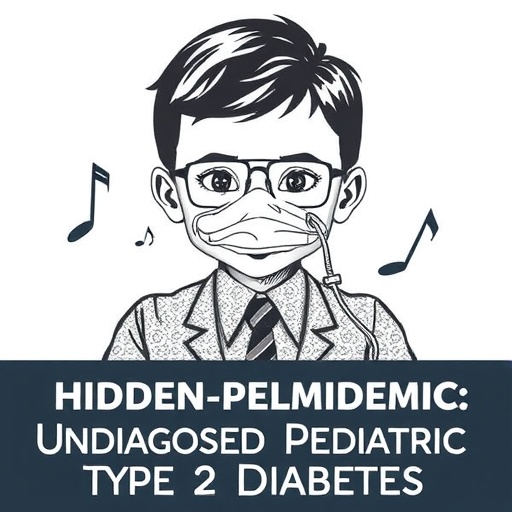
In the rapidly evolving landscape of global health challenges, pediatric type 2 diabetes mellitus (T2DM) has emerged as a silent but alarming epidemic. Despite widespread awareness of adult-onset T2DM, the pediatric population affected by this metabolic disorder remains largely undiagnosed and untreated, creating what researchers have aptly termed a “giant hidden iceberg.” This phenomenon underscores the urgent need for heightened clinical vigilance and public health strategies focused on early identification, intervention, and management of T2DM among children and adolescents.
Recent investigations by Pu and Fu, as detailed in their groundbreaking article published in the World Journal of Pediatrics, shed critical light on this underrecognized issue. Their work reveals that while obesity and sedentary lifestyles have been linked to rising pediatric T2DM rates, the true epidemiological footprint is obscured by diagnostic challenges and clinical inertia. The stealthy nature of pediatric T2DM means that many children harbor significant metabolic dysfunction long before symptoms become apparent, thereby elevating their risk for severe complications such as cardiovascular disease, nephropathy, and neuropathy in early adulthood.
At the molecular level, pediatric T2DM shares many pathophysiological traits with its adult counterpart, including insulin resistance and beta-cell dysfunction. However, the pediatric form often follows a more aggressive course, frequently accompanied by comorbidities like hypertension and dyslipidemia at an early stage. The interplay between genetic predispositions, environmental exposures, and psychosocial factors creates a multifactorial disease landscape that complicates both diagnosis and treatment.
.adsslot_lXq6AxdMC2{width:728px !important;height:90px !important;}
@media(max-width:1199px){ .adsslot_lXq6AxdMC2{width:468px !important;height:60px !important;}
}
@media(max-width:767px){ .adsslot_lXq6AxdMC2{width:320px !important;height:50px !important;}
}
ADVERTISEMENT
One of the critical hurdles in recognizing pediatric T2DM is the frequent overlap of symptoms with other common childhood conditions, or the complete absence of overt clinical signs in early disease stages. Many children remain asymptomatic, and standard screening protocols are either not widely adopted or inconsistently applied in pediatric settings. This diagnostic gap fosters a delayed initiation of therapy, which significantly diminishes the likelihood of favorable metabolic outcomes.
Advanced biochemical assays and novel biomarkers are now being explored to enhance early detection. For example, measuring levels of C-peptide and proinsulin, alongside traditional fasting glucose and HbA1c, could provide earlier indication of pancreatic beta-cell stress. Furthermore, continuous glucose monitoring technologies, while historically employed in type 1 diabetes, are gaining traction in the assessment of pediatric T2DM to capture glycemic variability and covert hyperglycemia.
The epidemiological data presented by Pu and Fu also highlight significant disparities in the incidence of pediatric T2DM, with higher prevalence noted in minority and socioeconomically disadvantaged groups. These populations often face barriers including limited access to healthcare, nutritional education, and safe environments conducive to physical activity. Addressing these social determinants is imperative for mitigating disease burden.
Metabolic syndrome components frequently coexist in pediatric T2DM, invoking a cascade of pathologies that can accelerate disease progression. Chronic low-grade inflammation and altered adipokine profiles, such as decreased adiponectin and increased leptin levels, worsen insulin resistance. These biochemical shifts culminate in endothelial dysfunction and contribute to early-onset atherosclerosis, underscoring the systemic implications of untreated pediatric T2DM.
Treatment paradigms for pediatric T2DM are evolving as new pharmacological agents demonstrate efficacy and safety profiles suitable for younger populations. While metformin remains the cornerstone of therapy, the advent of GLP-1 receptor agonists and SGLT2 inhibitors is reshaping the therapeutic landscape. Nonetheless, challenges persist in adherence, side effect profiles, and long-term data collection in pediatric cohorts.
Lifestyle modification remains a bedrock intervention, but its implementation is fraught with challenges. Intensive behavioral counseling, family involvement, and school-based programs are advocated to foster sustainable changes in diet and physical activity. However, these strategies require substantial resource allocation and tailored approaches to accommodate diverse cultural and socioeconomic contexts.
Importantly, early intervention has shown promise in altering the disease trajectory. Identifying prediabetic states through rigorous screening enables the institution of preventative measures before irreversible beta-cell damage occurs. Pilot studies suggest that integrated care models combining endocrinology, nutrition, psychology, and social services yield superior outcomes compared to conventional care.
The emotional and psychological impact of pediatric T2DM also warrants attention. Children diagnosed with a chronic illness encounter unique stressors including stigma, altered self-identity, and challenges in peer relationships. Mental health support integrated into diabetes care frameworks is critical for holistic management and improved adherence.
The “giant hidden iceberg” metaphor is apt, as the visible cases of pediatric T2DM represent only a fraction of the actual affected population. The latent, unrecognized cases constitute a reservoir of future health burdens that could overwhelm health systems if not proactively addressed.
In conclusion, Pu and Fu’s research elucidates the complex and multifaceted nature of undiagnosed pediatric type 2 diabetes mellitus. The silent progression of the disease in children demands a paradigm shift in clinical practice, public health policies, and research priorities. Efforts must focus on comprehensive screening protocols, innovative diagnostic tools, culturally sensitive prevention programs, and novel therapeutic options to stem the tide of this covert epidemic. Only through such concerted action can the massive, submerged portion of the pediatric T2DM iceberg be exposed, understood, and effectively managed before it claims a disproportionate toll on young lives.
Subject of Research: Pediatric Type 2 Diabetes Mellitus and Its Undiagnosed Prevalence
Article Title: Undiagnosed pediatric type 2 diabetes mellitus: the giant hidden iceberg
Article References:
Pu, JQ., Fu, JF. Undiagnosed pediatric type 2 diabetes mellitus: the giant hidden iceberg. World J Pediatr 21, 537–541 (2025). https://doi.org/10.1007/s12519-025-00917-3
Image Credits: AI Generated
Tags: childhood obesity and diabetes risksclinical challenges in pediatric T2DMcomplications of untreated diabetesearly intervention for pediatric diabetesinsulin resistance in childrenmetabolic disorders in adolescentsobesity and diabetes correlationpediatric health awarenesspediatric type 2 diabetes epidemicpublic health strategies for diabetessedentary lifestyle and diabetesundiagnosed diabetes in children






